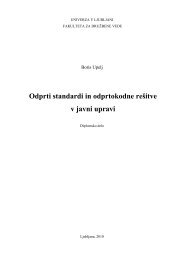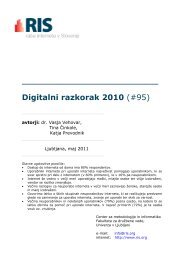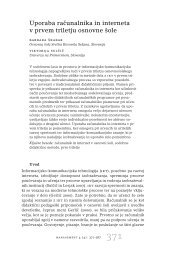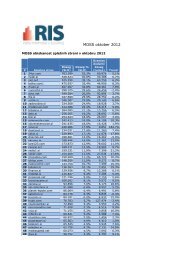the Labour Market Survey Report - Council of European ...
the Labour Market Survey Report - Council of European ...
the Labour Market Survey Report - Council of European ...
Create successful ePaper yourself
Turn your PDF publications into a flip-book with our unique Google optimized e-Paper software.
5.4 Robustness <strong>of</strong> Estimates<br />
As can be seen from <strong>the</strong> above, <strong>the</strong> approach using four scenarios involves an important degree <strong>of</strong><br />
robustness as compared with <strong>the</strong> IDC and Career-Space approaches, and <strong>the</strong> presentations have been<br />
designed to minimize risk <strong>of</strong> unwarranted confidence in <strong>the</strong> reader in any one future. However, as with<br />
all forecasting work, it is crucial to recognize that “future-gazing” is a risky business, and perceptions<br />
based on this model must continue to be questioned and tested, in particular by updating <strong>the</strong> model as<br />
new data becomes available, and errors between <strong>the</strong> new data and forecasts for it should be thoroughly<br />
analysed for lessons to be learned.<br />
In summary, <strong>the</strong> limitations to <strong>the</strong> analyses and forecasts in this study include <strong>the</strong> following:<br />
• Limited “granularity” <strong>of</strong> analysis resulting from having to work with only two occupational<br />
categories;<br />
• Likely imperfections <strong>of</strong> consistency in use <strong>of</strong> <strong>the</strong> ISCO classification by statistical <strong>of</strong>fices in<br />
different Member States in relating to national occupational classification frameworks;<br />
• Inconsistencies arising from o<strong>the</strong>r differences between <strong>the</strong> LFS data-ga<strong>the</strong>ring processes in<br />
different Member States, including variation in degree <strong>of</strong> use <strong>of</strong> proxy interviews (reported by<br />
Eurostat to be - e.g. - significantly higher in Spain than in Nordic countries)<br />
• Limitations to various analyses <strong>of</strong> specific characteristics <strong>of</strong> <strong>the</strong> occupational labour markets<br />
investigated (different “cross-tabulations” arising from statistical reliability limitations where<br />
sample size for <strong>the</strong> sub-sets fell below <strong>the</strong> relative level – confidence threshold generally shown<br />
in chart);<br />
• Limitations associated with <strong>the</strong> assumptions within <strong>the</strong> scenario model – in particular <strong>the</strong> shape<br />
<strong>of</strong> <strong>the</strong> “initial trough” curve.<br />
5.5 Preliminary Scenarios<br />
The “initial trough with varying underlying growth rate” forecasting model has been applied to <strong>the</strong> latest<br />
(2000Q2) figures for all ITPs (ISCO 213 and – where non-zero – ISCO312) both in <strong>the</strong> four Member States<br />
examined in more detail (see Annexes B, C, D and E) and <strong>the</strong> total for <strong>the</strong> EU as a whole – see Figure 20.<br />
The corresponding estimates for new demand each year until 2005 are given in Table 5. Replacement<br />
demand is assumed, as a preliminary rough estimate, to be 3% <strong>of</strong> initial stock.<br />
This leads to a set <strong>of</strong> cumulative (net, new) demand figures for <strong>the</strong> <strong>European</strong> Union for <strong>the</strong> four years<br />
2001–>2005 <strong>of</strong>:<br />
2% underlying growth: 583,000,<br />
5% underlying growth: 912,000,<br />
10% underlying growth: 1,505,000, and<br />
15% underlying growth: 2,592,000.<br />
(all figures rounded to <strong>the</strong> nearest 1,000)<br />
78<br />
| C E P I S I.T. PRACTITIONER SKILLS IN EUROPE | Section 5

















